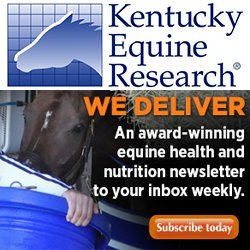
by Eleanor M. Kellon, VMD
I am personally very involved with medical causes, but this is about a central issue for all laminitis cases – the trim. Medications, diet and supplements can’t make up for an inappropriate laminitis trim.
Whether the horse has true rotation – coffin bone (P3) out of alignment with second phalanx (P2) – or capsular rotation – hoof wall pushed away from P3 by swelling or laminar wedge – the goal of trimming is realignment of the bones within the hoof capsule.
A realigning trim also corrects for the elevated palmar angle (angle the bottom of the coffin bone makes with the ground) seen in horses with true rotation. Reduced growth at the toe compared to heel can also result in this problem in any laminitis horse.
It’s that simple, and the realigning trim is as important today as it was when I learned it 45 years ago. Some things don’t change. The physiologically correct alignment between coffin bone, hoof wall and ground is one of them.
Many different shoeing and hoof appliance options have been suggested over the years. The one thing they all have in common is starting with a realigning trim. A major reason for failure of all these options is skipping the realigning trim or failing to maintain it.
In almost 25 years of dealing with hundreds of laminitis cases on the Equine Cushings and Insulin Resistance Group, the most difficult ones we get are those where the correct trim was not instituted or maintained.
If all laminitic horses would have radiographs done early, and trim corrections as needed from the beginning, we would have far fewer treatment failures.
For more information see Trim for the Laminitic Horse and Realigning Trim on www.ecirhorse.org.
About ECIR Group Inc.
Started in 1999, the ECIR Group is the largest field-trial database for PPID and EMS in the world and provides the latest research, diagnosis, and treatment information, in addition to dietary recommendations for horses with these conditions. Even universities do not and cannot compile and follow long term as many in-depth case histories of PPID/EMS horses as the ECIR Group.In 2013 the Equine Cushing's and Insulin Resistance Group Inc., an Arizona nonprofit corporation, was approved as a 501(c)3 public charity. Tax deductible contributions and grants support ongoing research, education, and awareness of Equine Cushing's Disease/PPID and EMS.
THE MISSION of the ECIR Group Inc. is to improve the welfare of equines with metabolic disorders via a unique interface between basic research and real-life clinical experience. Prevention of laminitis is the ultimate goal. The ECIR Group serves the scientific community, practicing clinicians, and owners by focusing on investigations most likely to quickly, immediately, and significantly benefit the welfare of the horse.
You can find more interesting articles in our section on Health & Education.

































